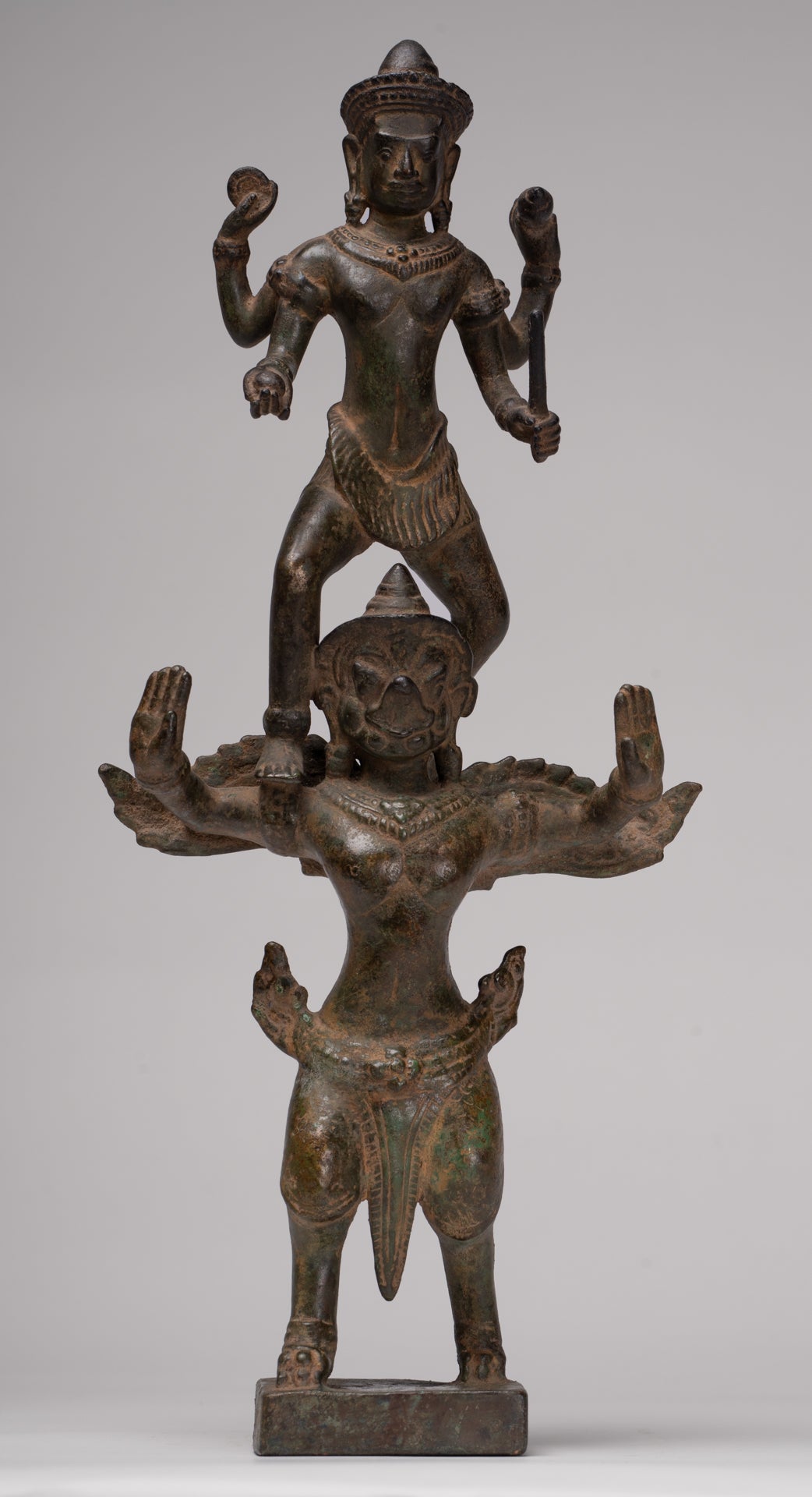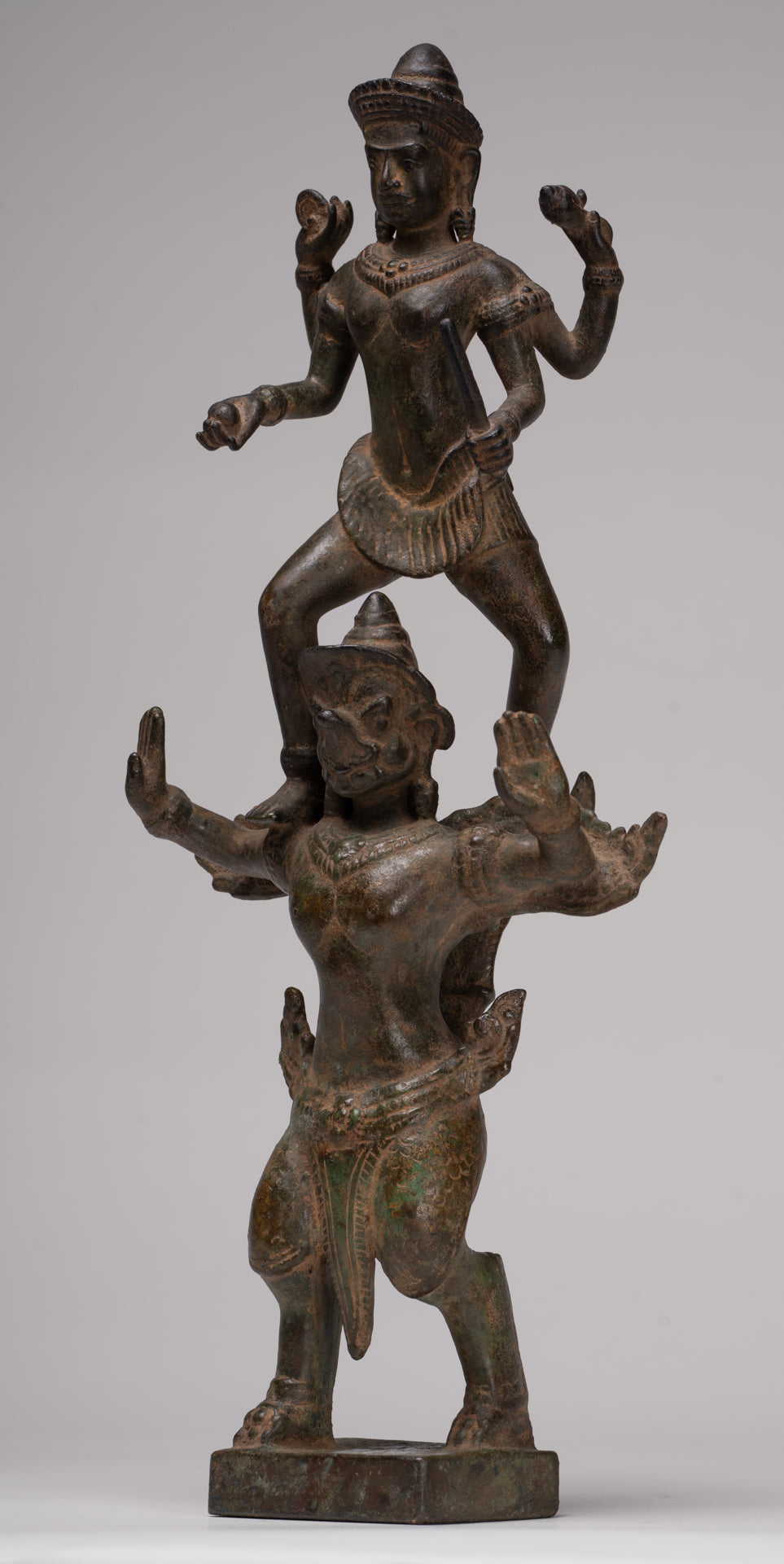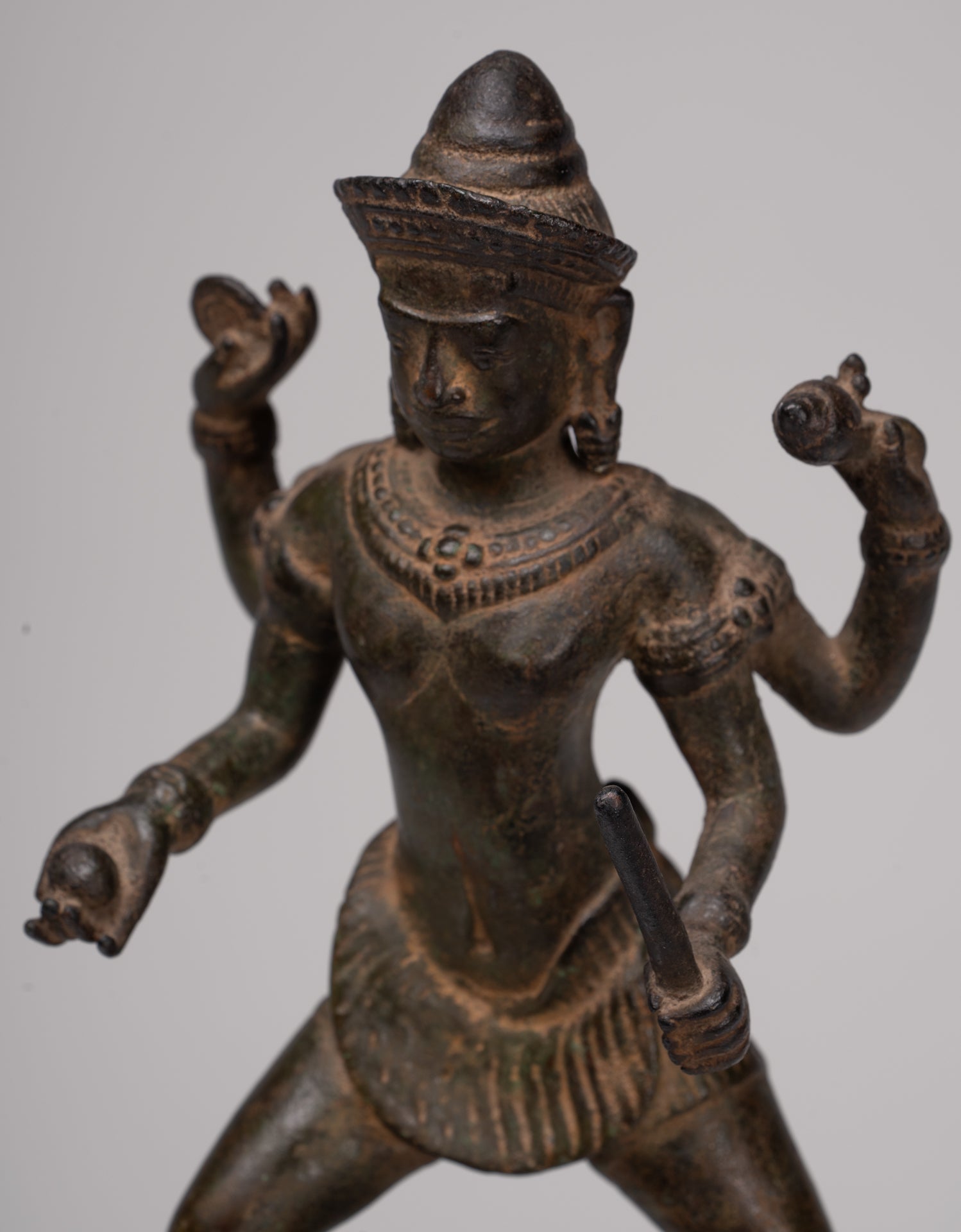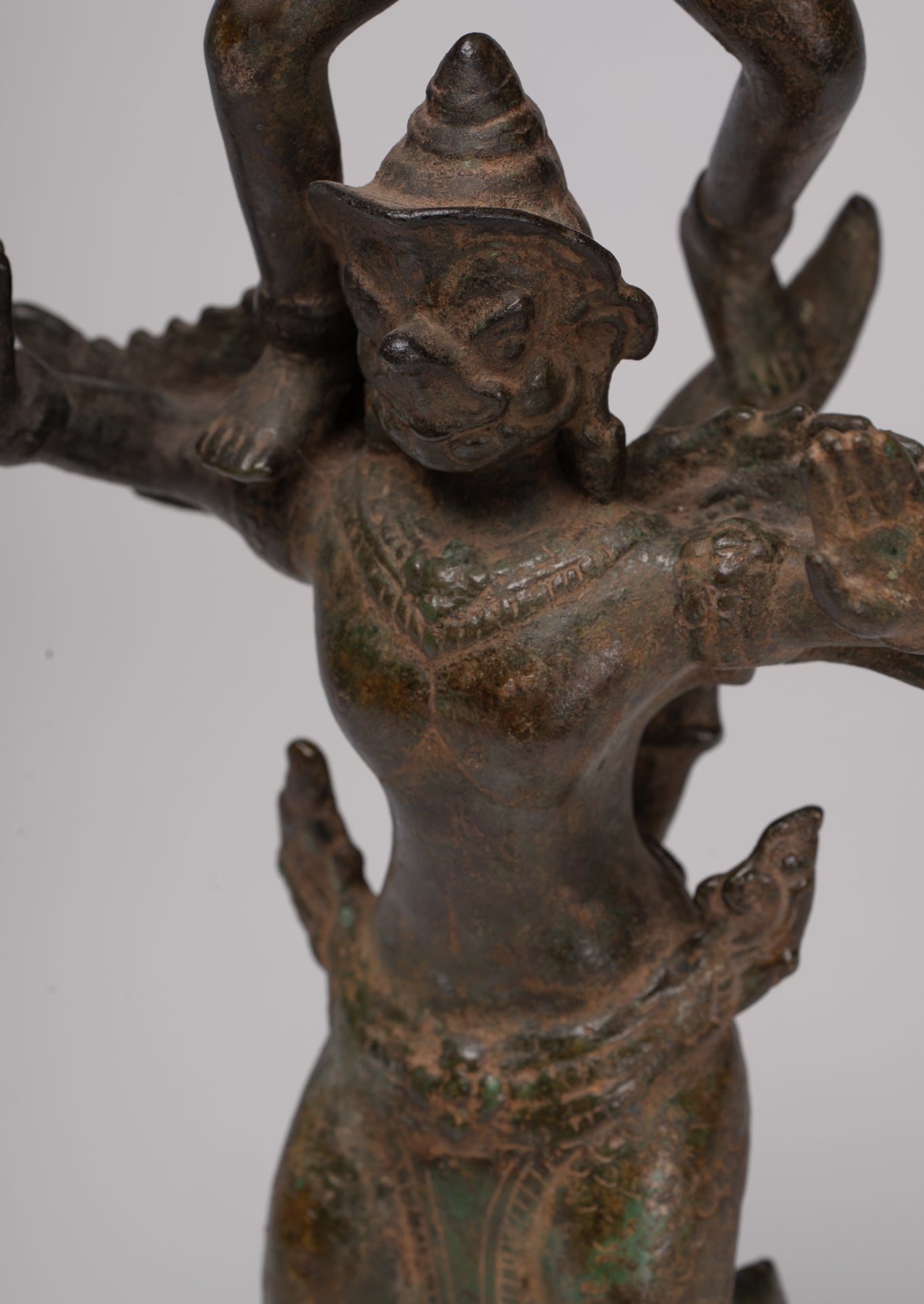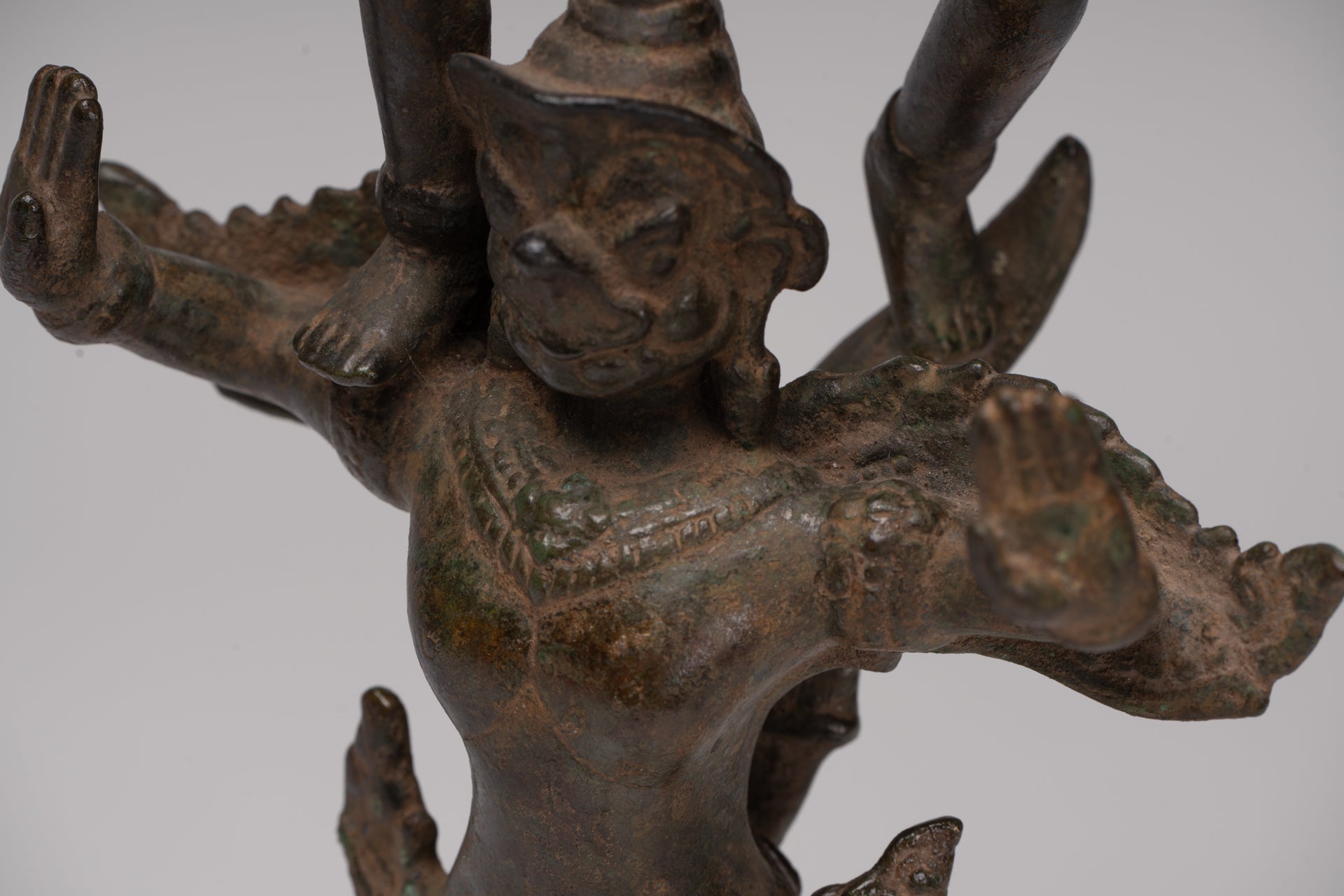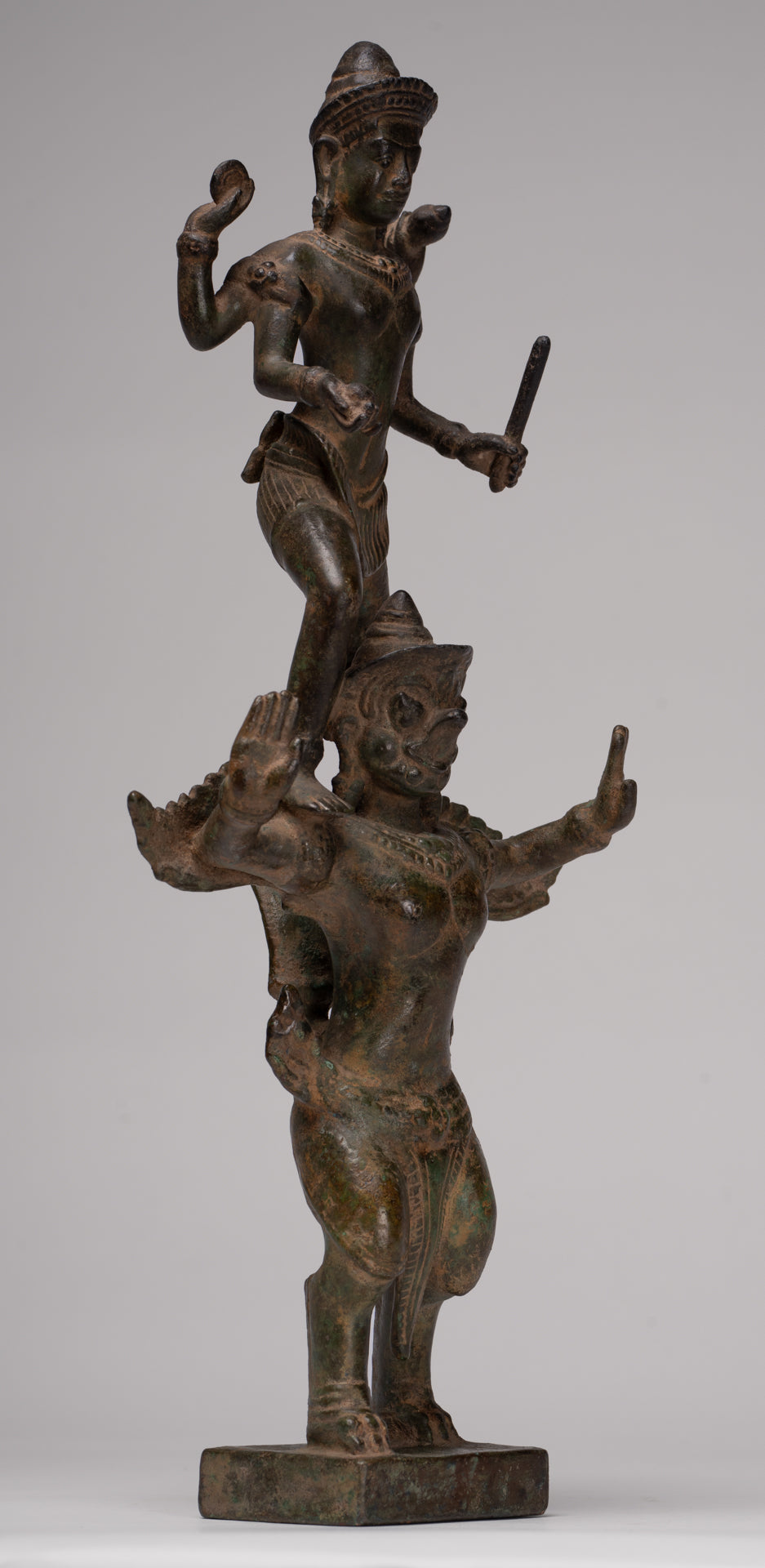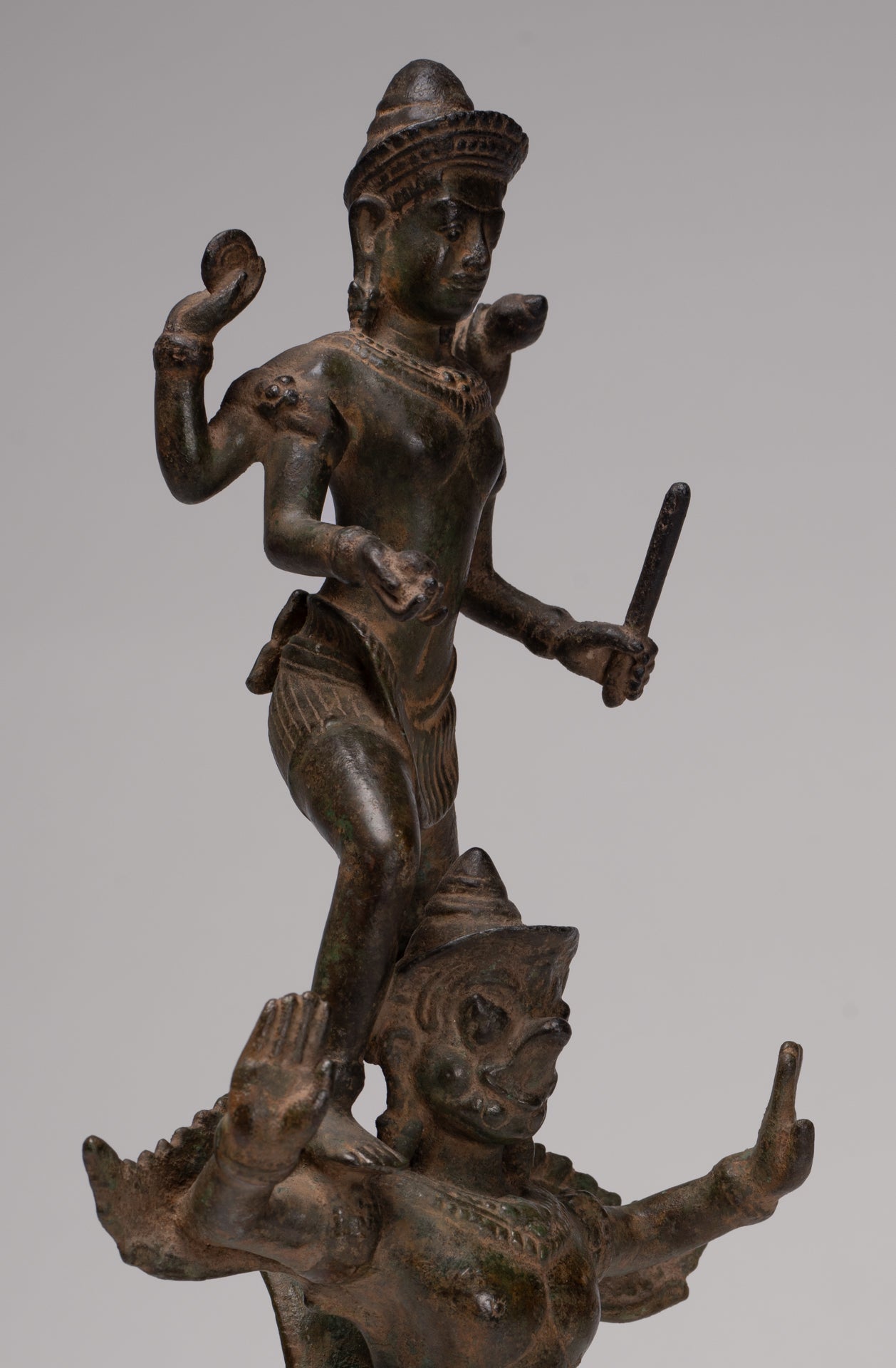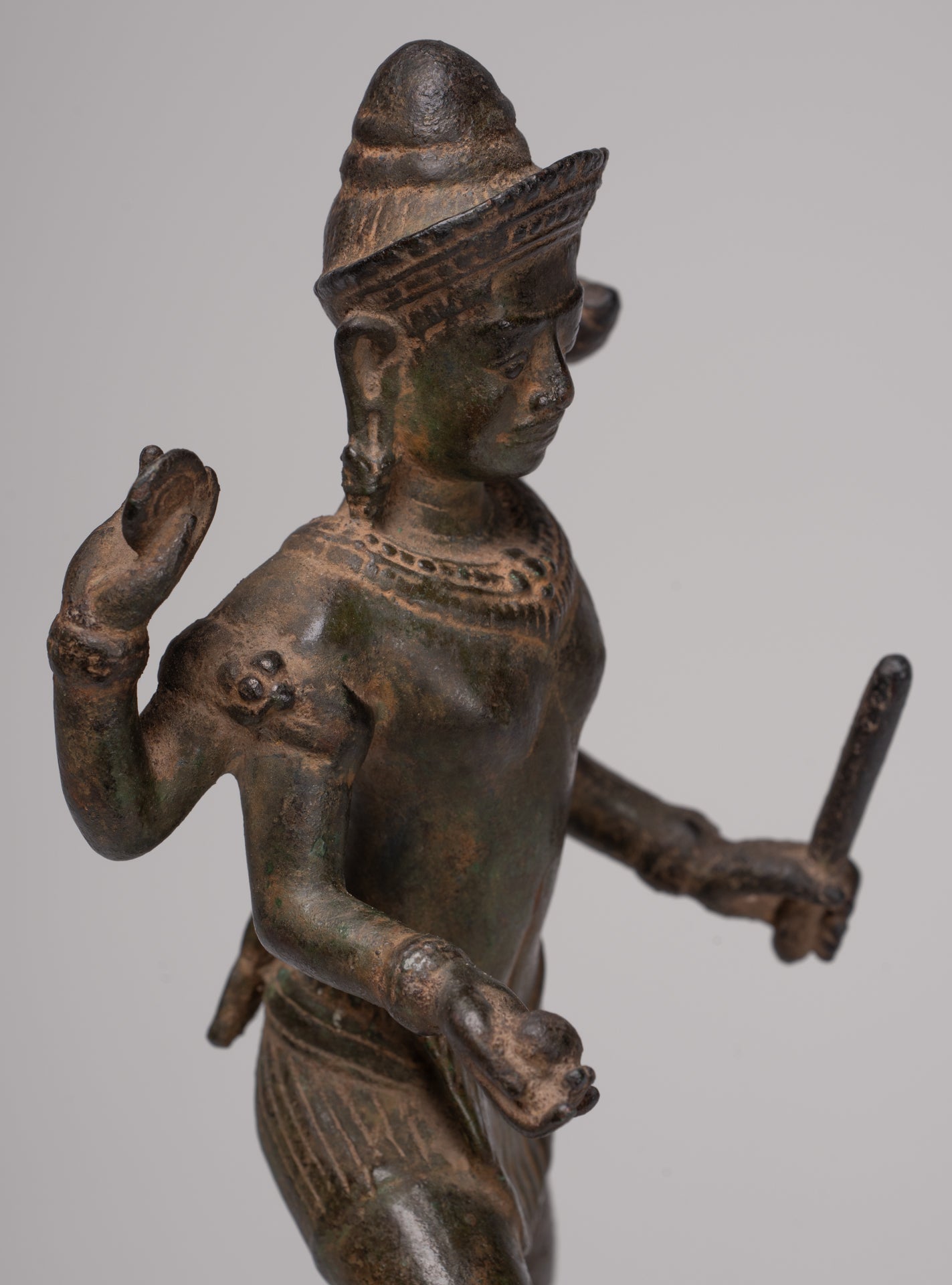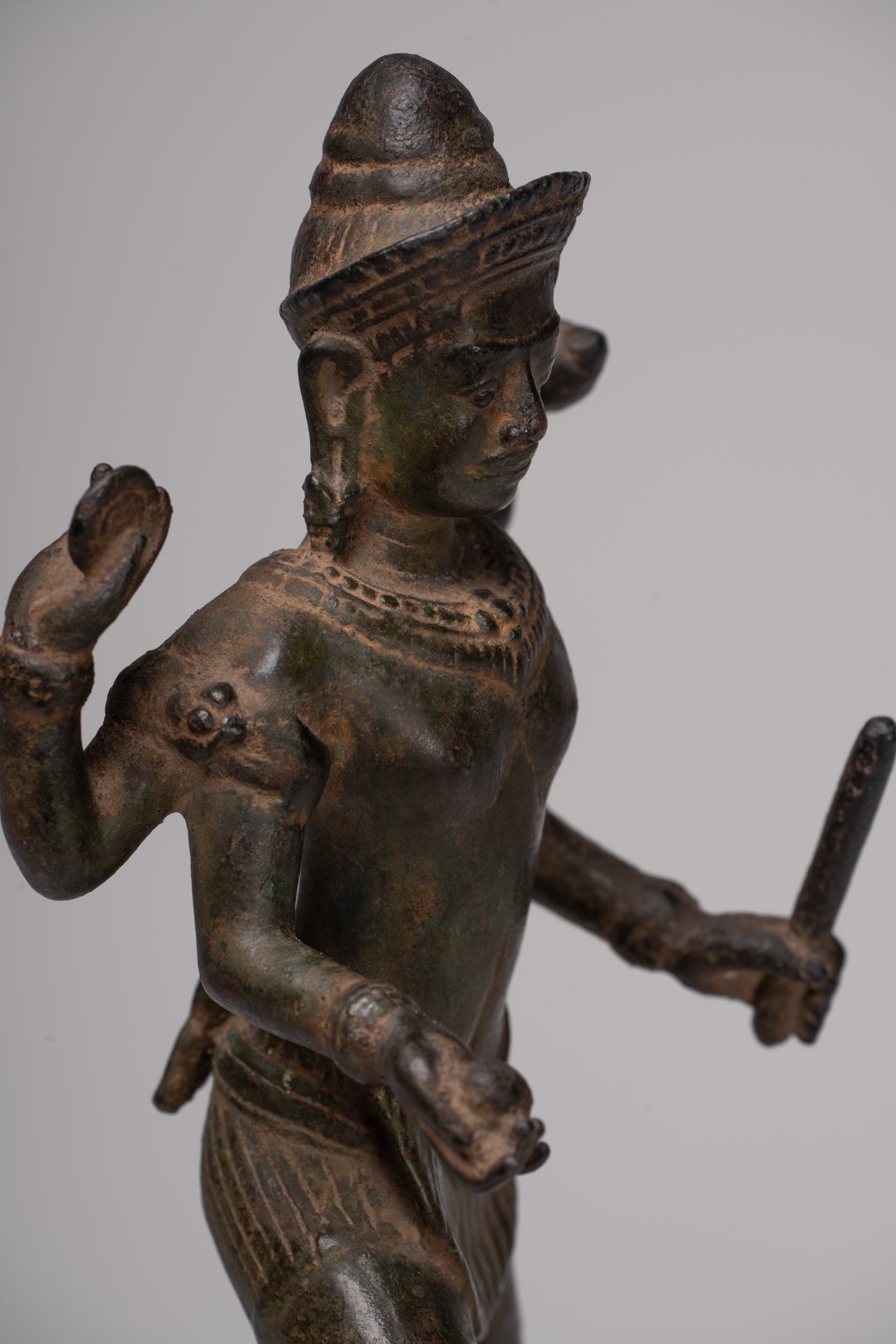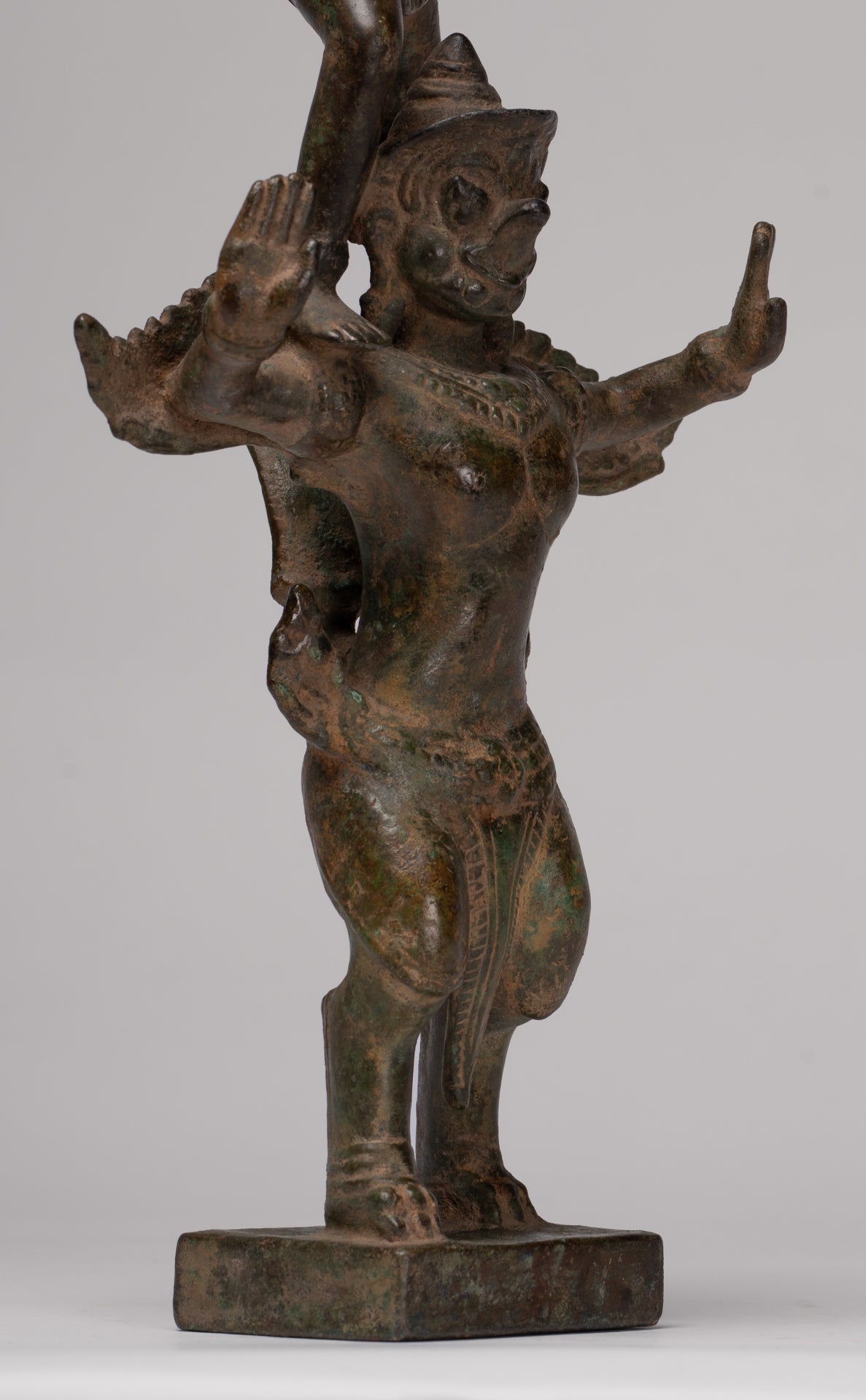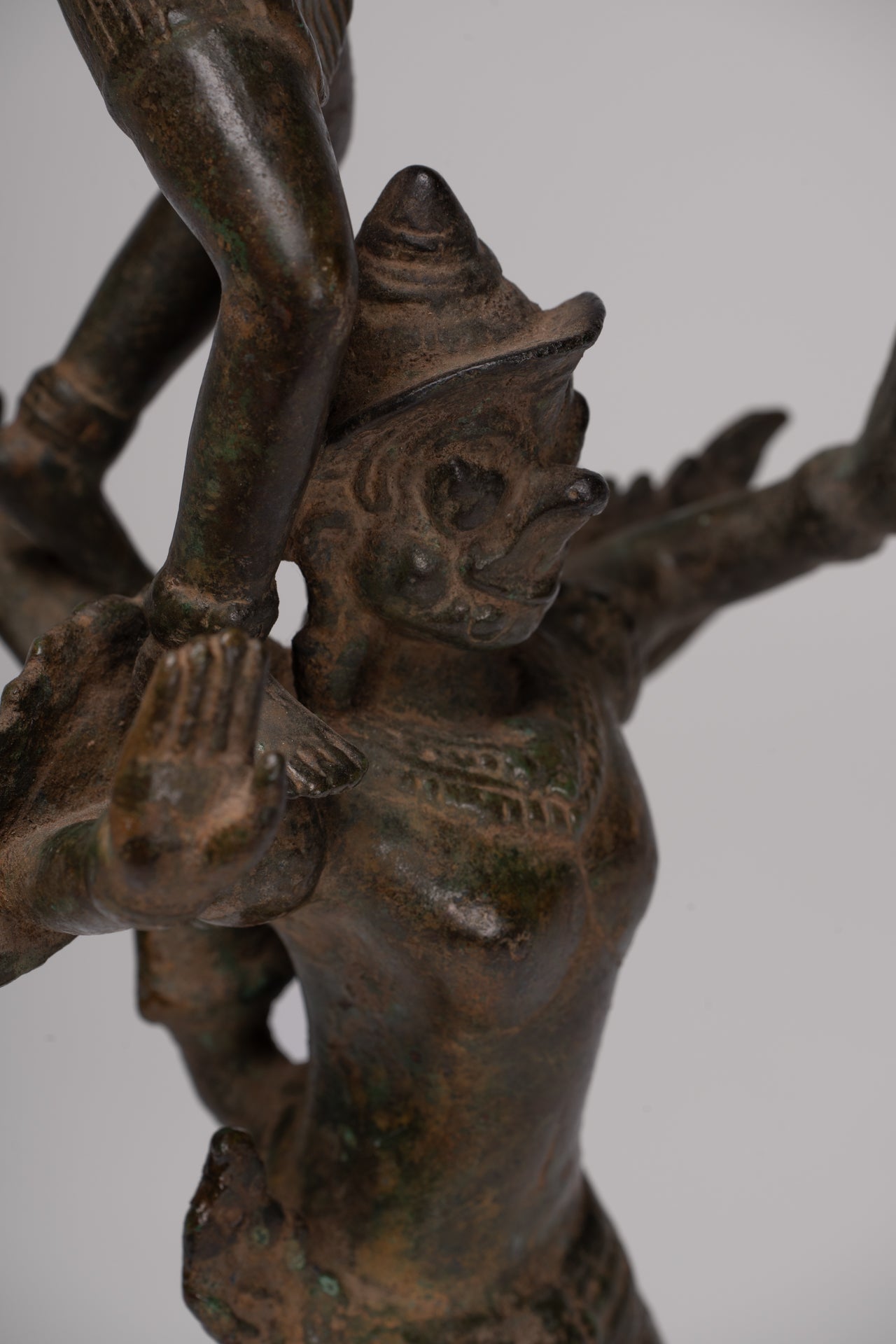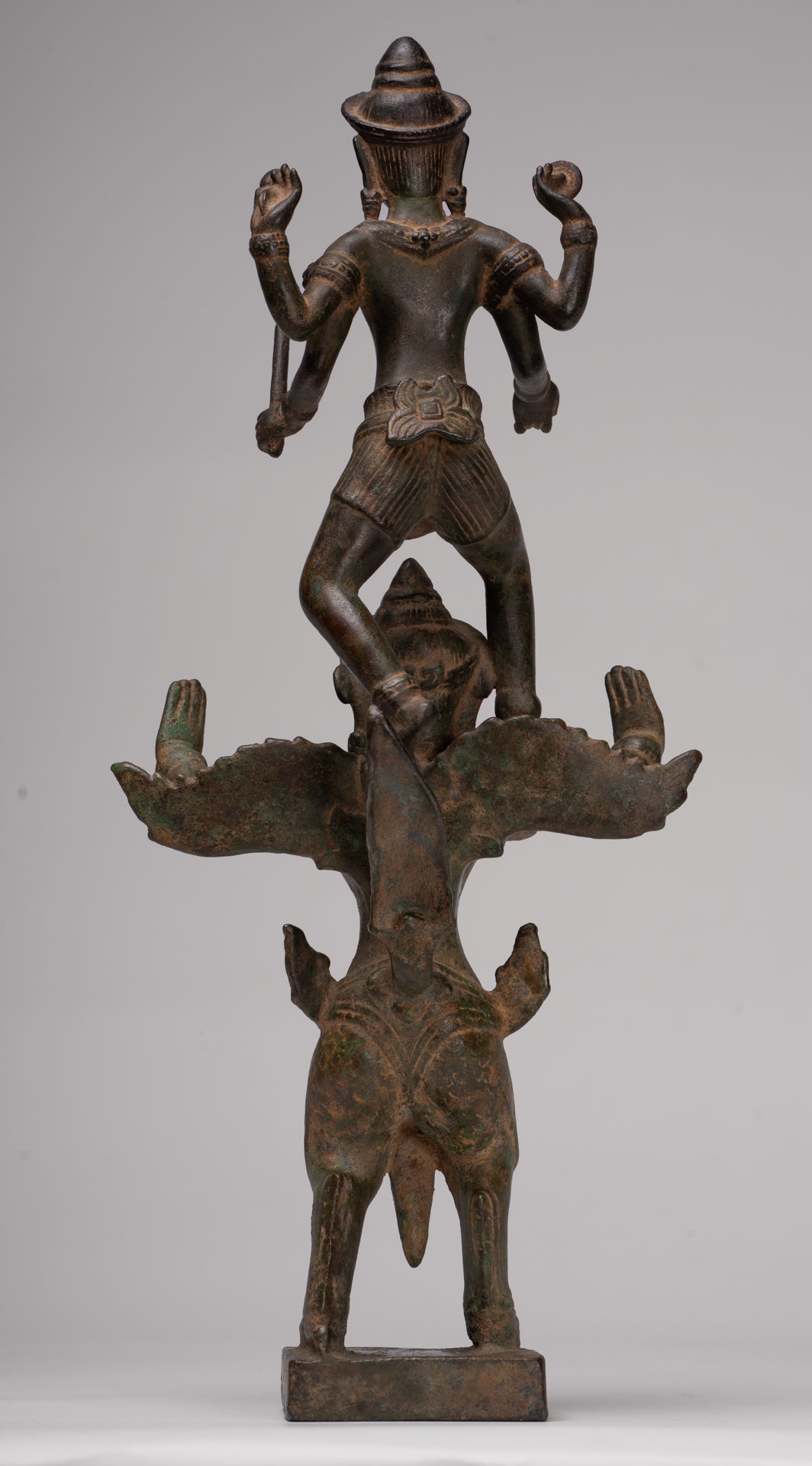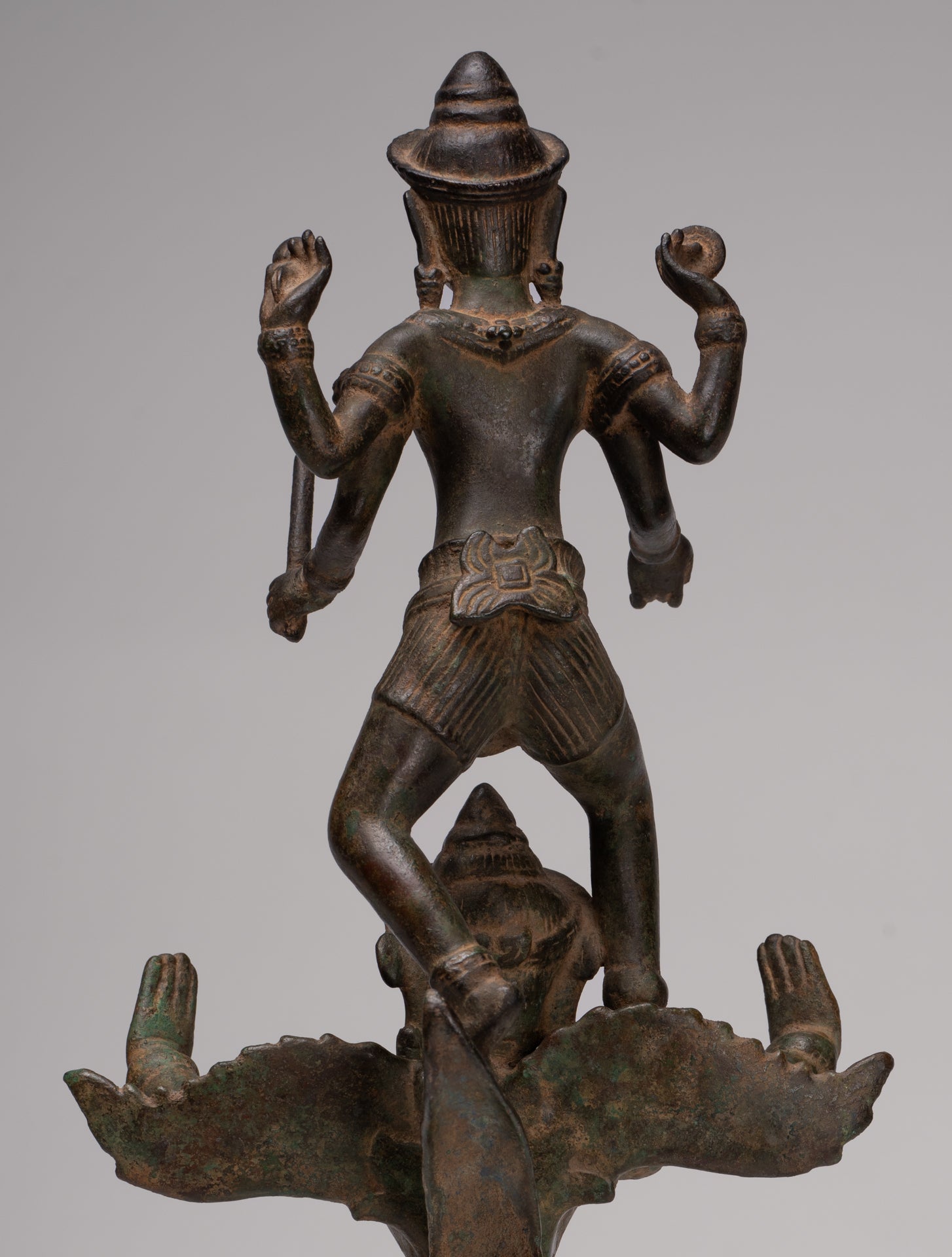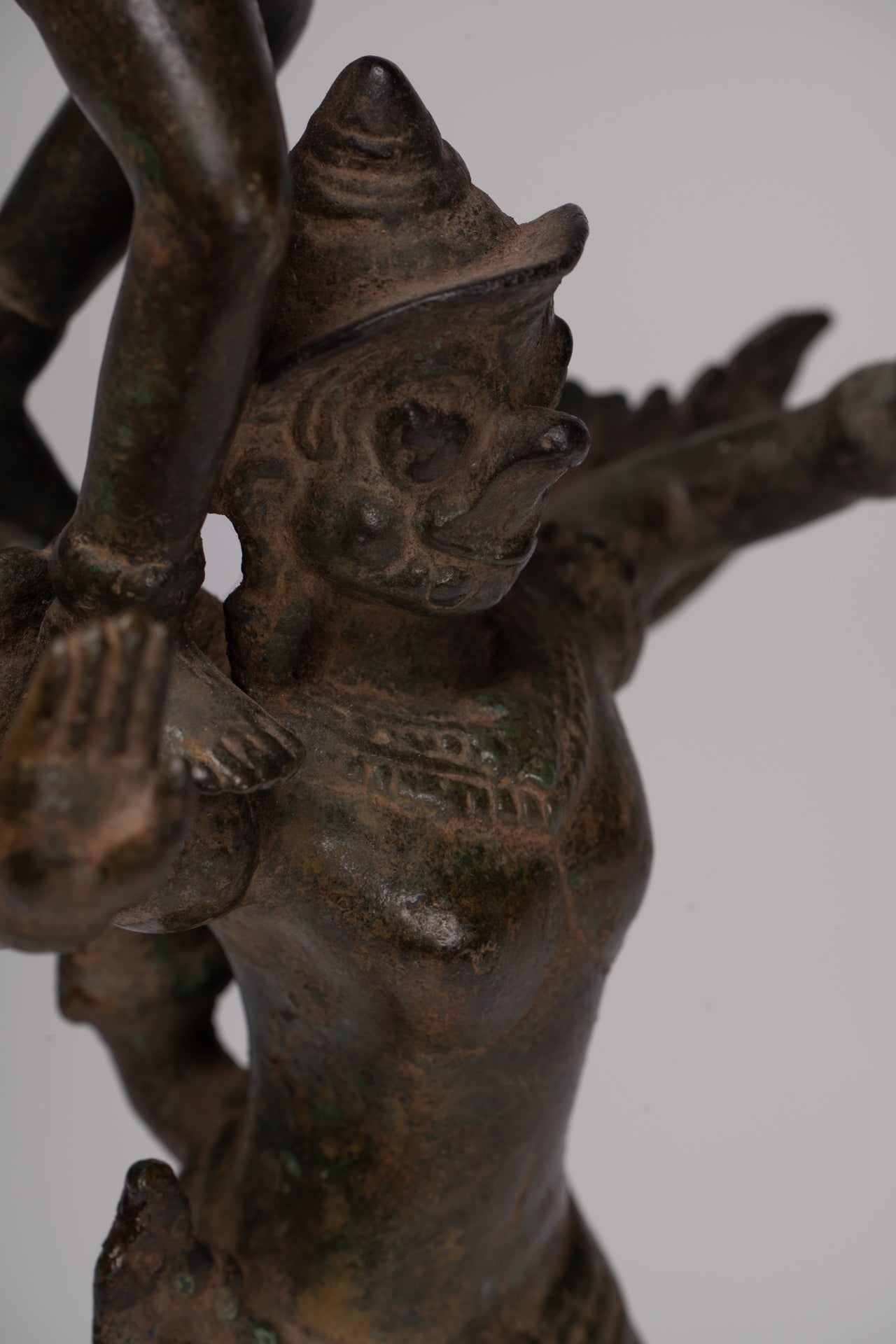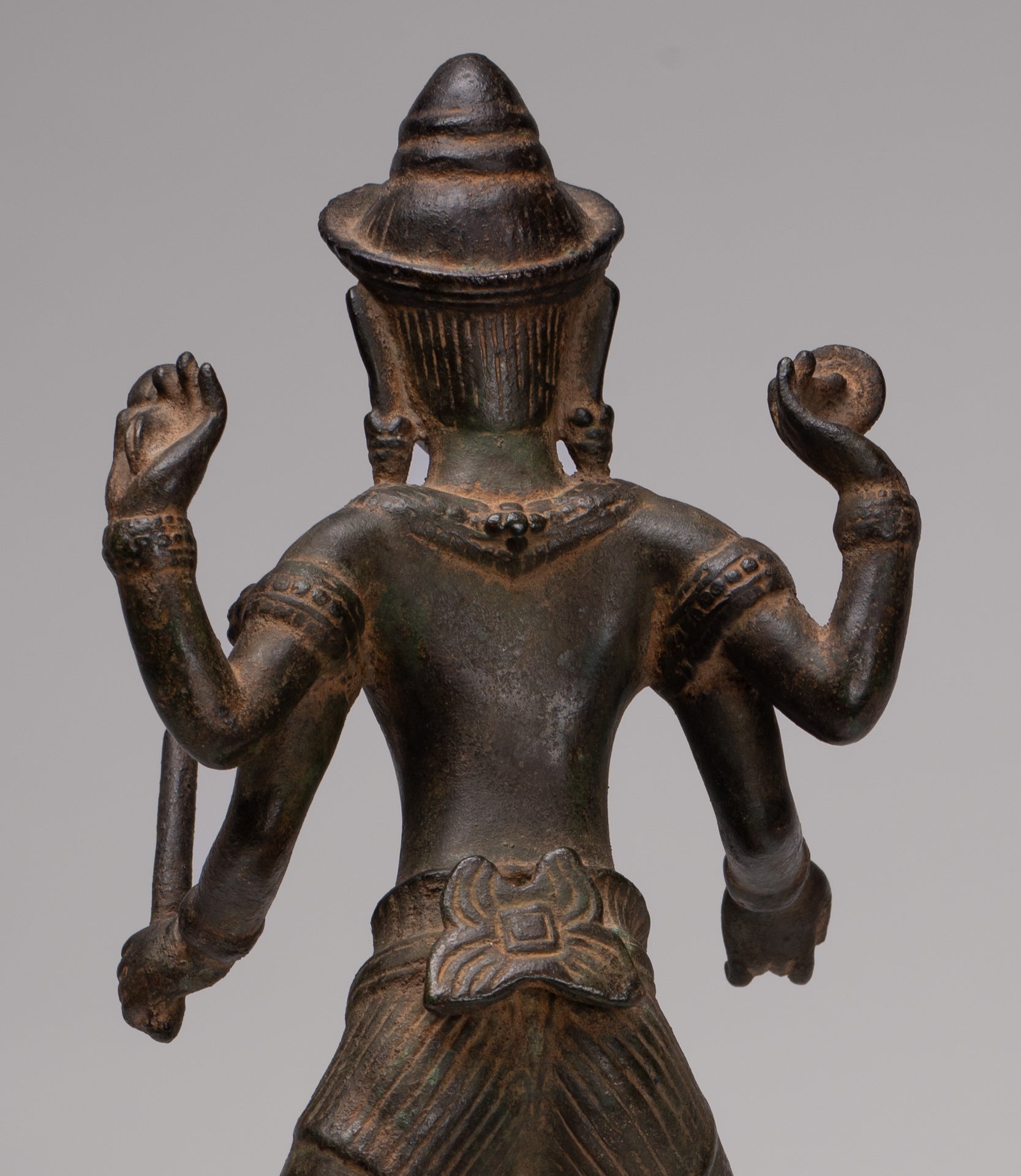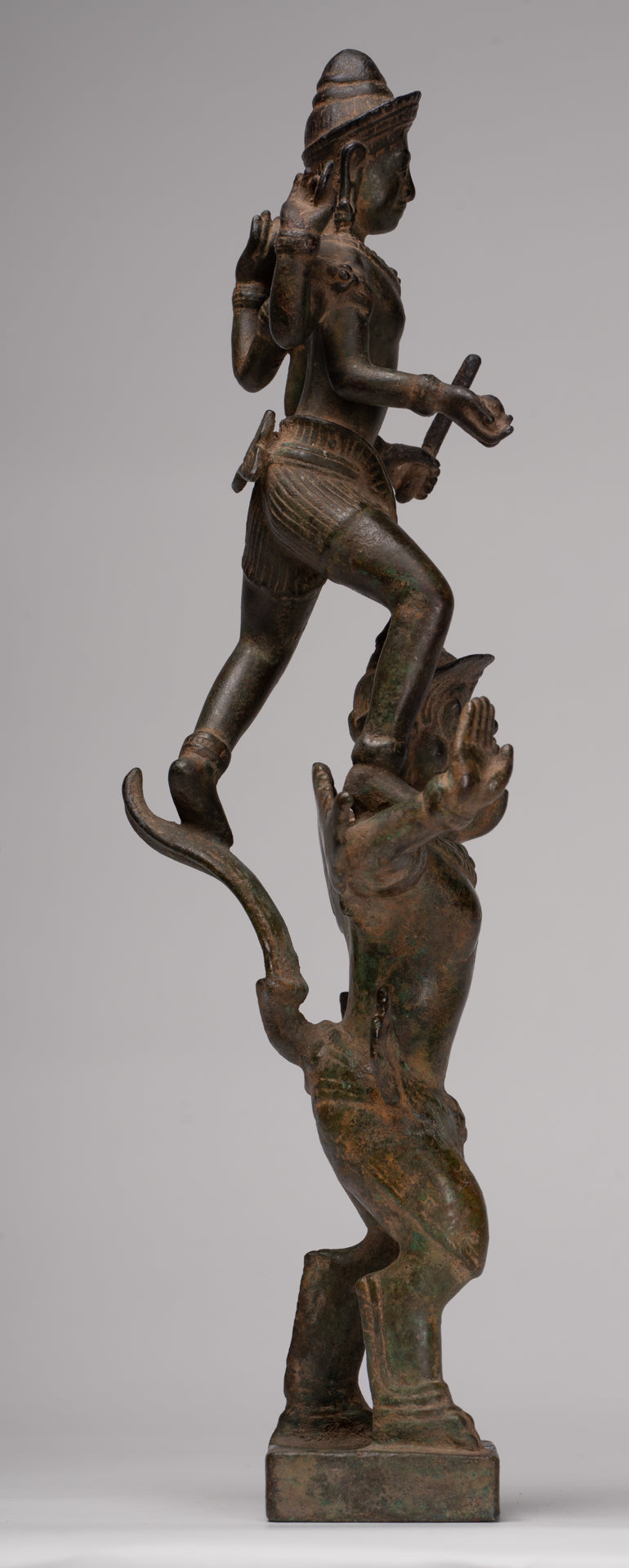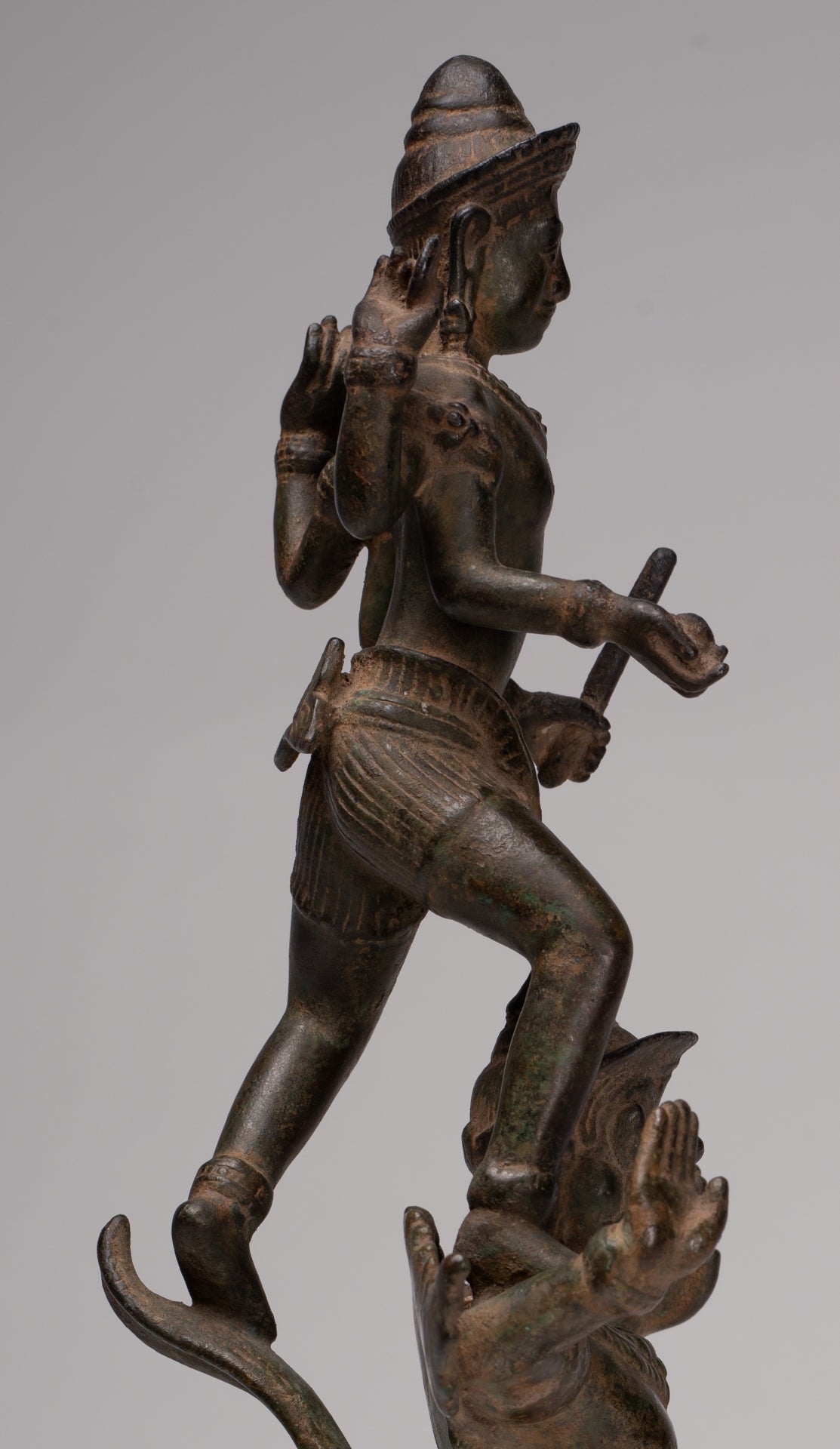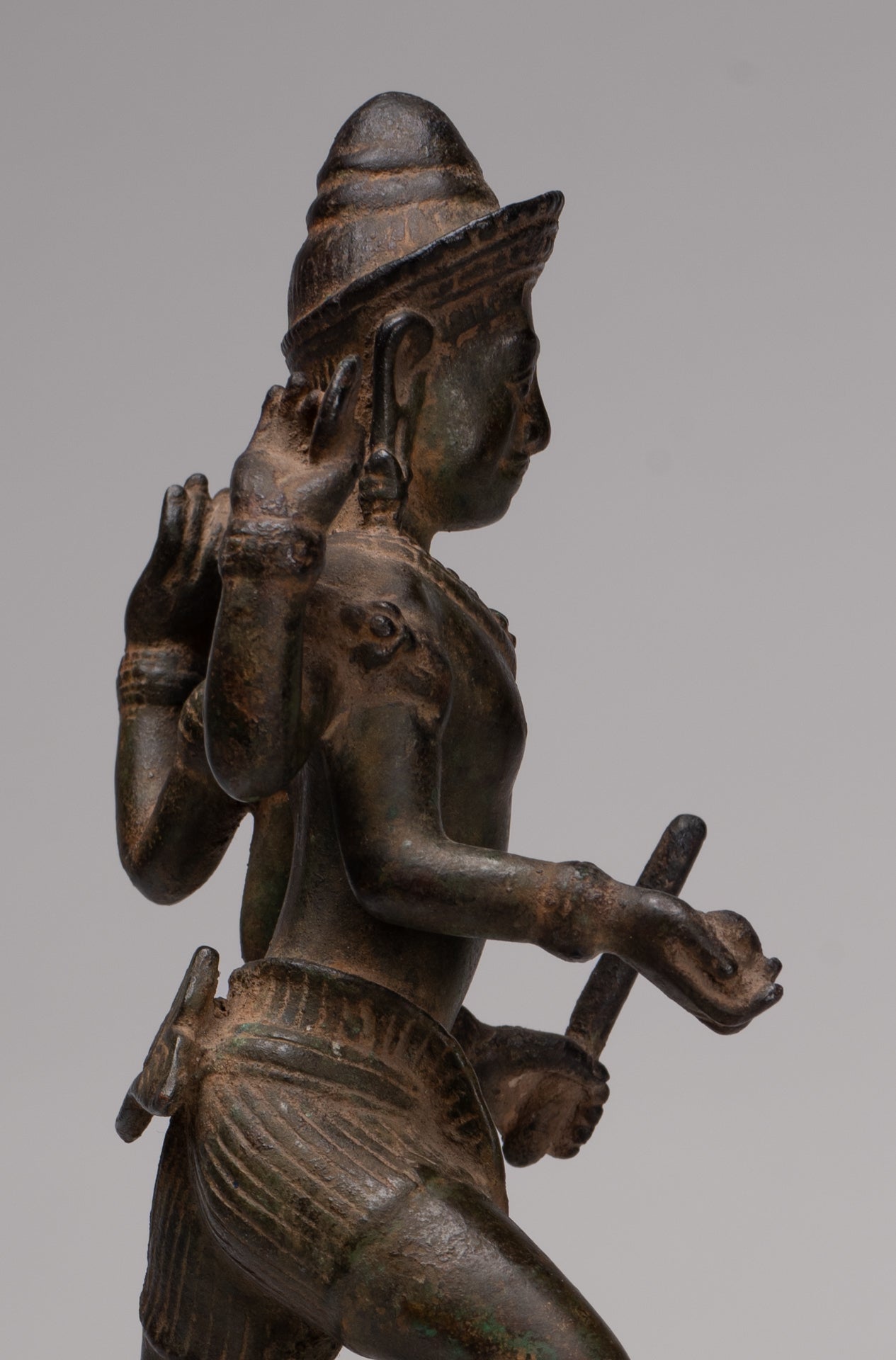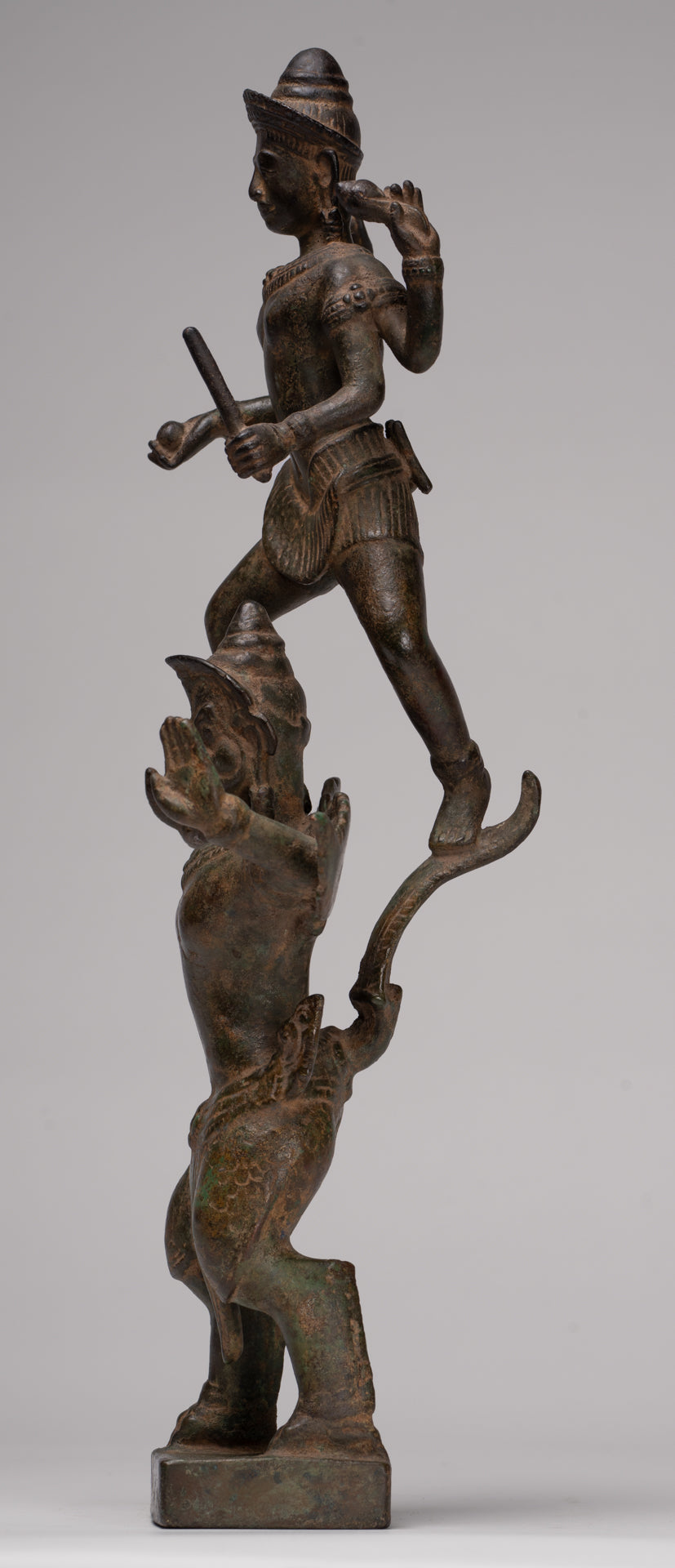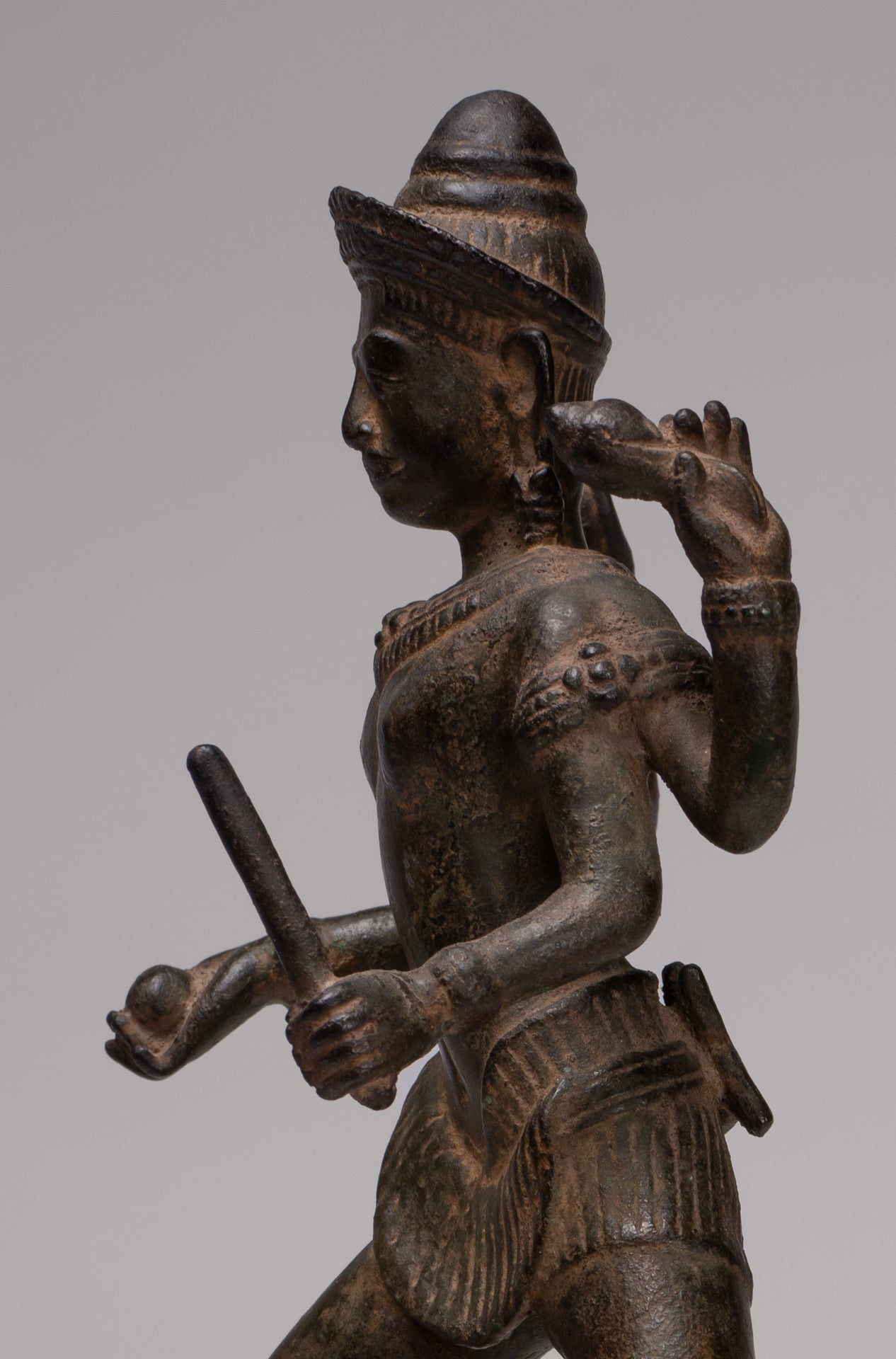-
Antique Khmer Style Bronze Khmer Baphuon Vishnu Statue Riding Garuda - 36cm/14"
Measures (Height) 36cm/14"
Weight - 3.6kg / 7.9lbs
An antique Khmer style masterpiece bronze Vishnu riding Garuda in pre-Angkor 11th century Baphuon style. Vishnu is the protector and preserver. His mount is Garuda.
The piece is a solid cast with a substantial weight. The craftsmanship and quality of this unique piece is self-evident.
Vishnu is the divine Hindu preserver and protector of human life, a role that provided natural analogies with earthly kingship for the Khmer. The Vishnu embodies authority with its iconic downcast gaze and serene face.
The Baphuon period is generally considered to have occurred between the 11th and 12th centuries CE, during the reign of King Udayadityavarman II in the Khmer Empire. This period falls within the broader timeline of the Angkor era, which encompasses the height of Khmer power and cultural achievement.
As is typical with the Baphuon style, the general silhouette is heavier. The casting is beautiful as you can see in the fine details of the face and hands. Details are rendered perfectly. The features suggest the prana, or inner breath, that signifies superhuman power. The fullness of the forms give the face a softness which accentuates the eyes opened wide, and the fleshy and sensual lips. The anatomy shows a strong sense of observation.
The overall silhouette is elegant and a reminder of the Pre Angkorian Art. The ornate carving of the diadem provides a delightful contrast with the smooth, polished, facial features. The inner rims of the ears display the characteristic tripart scalloped treatment. The face is defined by slightly arched eyebrows, full rimmed lips, wide open rimmed eyes and a rather broad, flat nose.
Characteristic of the Baphuon period, the hair is drawn onto the top of the head to form a bulb shaped-chignon, held in place by a worked gold chain or a garland of flowers.
The deity is masterfully modelled in realistic human form, stood in a strong frontal posture. Given the qualities of the Vishnu it is clear that the original sculpture expected this masterpiece to be viewed in the round.
The Vishnu statue has a slender waist, broad hips and shoulders, wearing a vertically striated sampot high at the back curving steeply in the front to below the navel, bound by a plain belt. The fabric pulled between the legs and wrapped around the belt at the back, the pleated ends forming a 'butterfly wing' shape. The folds are of an extreme finesse. We are in the presence of a work of art of great quality.
In his hands, Vishnu holds his conch shell, a chakra discus, pinda and in his lower left hand his gada or mace symbolising his mental and physical strength.
As with images from this period, the ornamentation reflects a perfect mastery of sculpting and fluidity. Facial features of the statue retain characteristics of the previous Banteay Srei style, but appear more delicate. Generally, the statues are small in size, a feeling of elegance and softness is given off by the whole.
Important in both Hindu and Buddhist religions the Garuda is a large mythical bird with a wing-span of many miles, the bearer of Vishnu.
Garuda, the mythical bird-like creature, holds a revered place in both Hindu and Buddhist traditions. Known for his immense power, speed, and his role as the mount (vahana) of the Hindu god Vishnu, Garuda is a symbol of strength, protection, and the triumph of good over evil.
In Buddhism, Garuda is also a significant figure, often depicted as a protector and a symbol of wisdom.
Garuda's origins are rooted in ancient Indian mythology, particularly in the Vedas, Puranas, and epics like the Mahabharata and Ramayana. According to Hindu mythology, Garuda was born to Vinata and sage Kashyapa. His birth was marked by extraordinary events, as he emerged fully grown, radiant, and powerful. Garuda's most famous myth involves his quest to obtain the nectar of immortality (amrita) to free his enslaved mother from the clutches of her sister, Kadru, and her serpent sons, the Nagas.
Perhaps with a little 'poetic license' we are told that when the Garuda flaps it's wings hurricane winds arise that darken the sky and blow down houses.
In both Thailand and Indonesia the Garuda is seen as both a National and Cultural symbol.
The malachite and azurite patina and details of this piece are particularly appealing.
SATISFACTION GUARANTEE - We have been offering SE Asian Art for many years and are proud of the reputation we have developed for fair and honest listings. However, if for any reason, whatsoever, you are unhappy with your purchase please just let us know and we will provide a full refund. We want you to be 100% happy with your purchase.
-
The majority of orders will be shipped with DHL. This is a secure, express and fully tracked service.
Items less than 2Kg we typically ship using Royal Mail.
Once we receive your order we try to ship all orders the same or next working day.
Large and/or fragile pieces requiring palletising, specialist crating and/or extra packaging may take a little longer. Palletised shipments will be delivered curbside.
All orders over 35 GBP will be shipped free of charge.

-
We genuinely hope that all purchases delight.
However, if they do not, regardless of reason, we will refund all orders upon receipt of the unwanted item. Just notify us within 14 days of receiving your order that you wish to make a return and send the piece back to us with 30 days of delivery.
Let Us Help You Find The Piece You Desire
What Our Customers Think
Today I've received Your angkor stele. It's quite splendid. Thank you very much for your mindful and fast shipping. I hope a chanse will come again.
Miki, Osaka, Japan
Just a quick note to let you know your package arrived in fine shape a while ago. (DHL, your shipper, is a very good shipping service; even though I wound up being home when the delivery was made, I was glad to have been able to pre-arrange my electronic signature/authorization to leave the package on my porch, should I not have been home to receive it; that option is a very nice one as it saves the recipient from having to wait around all day, in order to sign for a delivery. I very much like the bronze bust. The coloring is particularly appealing. I've placed it on a bookcase just inside the front entry...it looks great!!!. Very handsome piece. Thanks again for having shipped so quickly, for packing the bust so carefully and for your helpful statuses throughout the transaction process. You are so very good to do business with.
Andrew, Tampa, FL, USA
The Buddha statue arrived yesterday, and we are delighted with it! It's a very handsome addition to our collection.
Susan, Detroit, MI, USA


